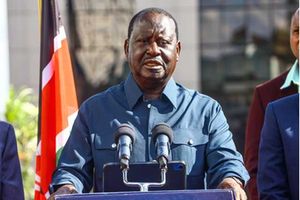Mweiga house is ideal for Mwai Kibaki papers and mementos

The palatial home built by the government for former President Mwai Kibaki in Mweiga, Nyeri. The home can host the former president’s archives.
Mwai Kibaki is dead. But his papers and mementos, scattered all over government archives, and in private folders and holdings, are still alive. How we preserve them – and where we assemble them is the other question.
While this will not find a quick answer, we have this elegant Sh400 million building in Mweiga, which was supposed to be his retirement home, and which never came to be. The value of Mwai Kibaki, the politician, and the person, will only come to light in history once all his papers are collected and archived in a presidential library — and when students of history, political science and economics start to unravel his thinking and how he impacted the Kenyan state.
It is quite surprising, though not shocking, that the Mwai Kibaki autobiography, which has been in the works for more than 10 years, was never published during his lifetime. This is sad, given that Kibaki was not only a politician but a scholar — a man who loved the written word.
How will Kenyans remember Kibaki in 50 years if we don’t preserve what we can easily get now?
Despite all his failings, President Daniel Moi commissioned British writer Andrew Morton to tell his story in the book, Moi: The Making of an African Statesman, while Jomo Kenyatta’s story has been told, partly, by Jeremy Murray-Brown and also by George Delf in their separate biographies on the first Kenyan president. He has also been studied by various public historians and academics. More so, Jomo authored three books: Facing Mount Kenya; Suffering without Bitterness; and My People of Kikuyu and the Life of Chief Wang’ombe.
The history of a nation is, partly, the histories of its personalities. And as I have voiced here before, a presidential library is not only a reservoir of memory but an appreciation of how power is created, dismembered, and remembered. How we choose what to remember and what to forget is part of our history.
When I was in the team that put together President Kibaki’s photobiography, we were confronted with the question of the whereabouts of Kibaki papers and old photos. The filing has been bad. Isaiah Kabira, then Presidential Press Service head, did a lot of digging and got some — but still, we only scratched the surface for a man who had spent 50 years in politics.

President Mwai Kibaki speaks to a schoolboy during a past function.
At one point, I drove to Mang’u High School where then principal, the late Henry Raichena, showed me some files which had the history — and stories — of old students. Here, after a two-day search, I retrieved what I was looking for: a school record that showed Kibaki’s performance as an ‘A’ student. I still think that Mang’u holds more on Kibaki — the school boy — than time could allow me to search.
It is now more than 40 years since the death of Jomo Kenyatta and it is a scandal that we don’t have, yet, a presidential library containing his papers and mementos. I know the family has been collecting them, which is a positive move. But that we have no website where we could have a glimpse of the good old Jomo — the way you can, for instance, check either Gerald Ford or Ronald Reagan and access their papers and photos from their database — is our national shame. Also, two years after the death of President Moi in February 2020, we have not heard about any desire to preserve his legacy as the longest serving Kenyan president. I wonder whether any university has ever thought of teaching a course on Nyayoism.
Some two years ago, President Uhuru Kenyatta announced the formation of presidential libraries for the legacies of past presidents. But a presidential library, as a public reservoir of memory, is more than retrieving past photos and sharing them on Twitter. It is about leading national debates, fact checking, agenda setting, and raising the bar on historical research.
Since nations no longer construct obelisks and monuments for their past leaders, presidential libraries have filled that void and allowed the supporters — through separate foundations — to reconstruct and preserve the legacies to the extent that it does not falsify or revise history.
However this falsification, at times, happens, and the classic example is at the US President Richard Nixon’s library where the interpretation on Watergate tapes and whether Nixon tried to stop the investigations is different from the accepted version of the scandal that brought him down.
“By the library’s account, the entire scandal boils down to the misinterpretation of a few words. Visitors, if they believe this interpretation, see the smoking gun vanish and wonder how this misunderstanding about a few words could possibly have brought down Nixon’s presidency,” writes Benjamin Hufbauer in the book, Presidential Temples.
Kibaki was not only instrumental in shaping Kanu’s history but also managing the party that formed Jomo Kenyatta’s government. I have seen some of these papers in various archival files — though I am not sure we have a complete Kanu minute files that captures this early history. Either they disappeared when Kanu was neglected as a party, and replaced with Kenyattaism — thanks to the eclipsing and banning of opposition — or when the party was moving offices. There could be minutes in private holdings.
Similarly, we might need to check the records in Makerere University and London School of Economics to get a glimpse of Kibaki’s student days. These would form a good part of a Kibaki Presidential Museum and Library.
In my casual check around some international archives, I have seen Kibaki’s name feature in some British records at Kew Gardens and some US archives — in the latter, filed in separate presidential libraries when he was Finance minister.
At the Kenya National Archives, with its rich records on the Ministry of Commerce and Industry and later Finance, we have lots of dossier on how Kibaki contributed to the construction of Kenya’s business and the Africanisation policy. Also, he was also key in handling the Asian question and negotiating for the arrival quotas that British would allow from Kenya.
Mwai Kibaki: The iconic leader with an indelible legacy
Besides this, Kibaki’s contribution on the floor of the House was epic. How his brilliance shaped debates, either on the floor or at the various committee stages, has yet to be appreciated. What we know is that if there ever was an informed debater, Kibaki has always ranked at the top and a proper compilation from the Hansard is necessary for historical reference.
And that is where this splendid Mweiga house comes in handy. If such a home is to be put to any use, the best would be to use it as a research facility where the Mwai Kibaki chronicles of his life are stored and where his museum can be located. It would not only attract researchers, but also tourists — now that we have decided that we shall never have a hero’s cemetery and that presidents, once dead, are buried in their villages.
If such a house is not available, all will not be lost if institutions such as the Dedan Kimathi University, which Kibaki was instrumental in setting up, could put together a Kibaki archives.
I hope the Mwai Kibaki Foundation will think about these things, seek funds from his friends and make sure his legacy lives on. More so, that the Kibaki autobiography is published as a history document.
And that is the only way we can remember Mwai Kibaki, the person. Anything else will be an ego trip and a complete erasure of history. And this also goes to Jomo and Moi – proper working presidential libraries are now becoming urgent.
Thus, the Mweiga house should be an ideal site for the Mwai Kibaki archives – after all, it was built with taxpayers’ money.
[email protected] @johnkamau1





